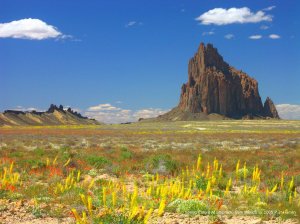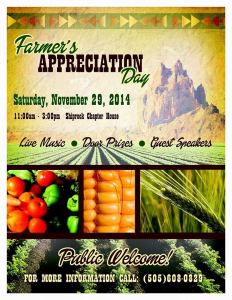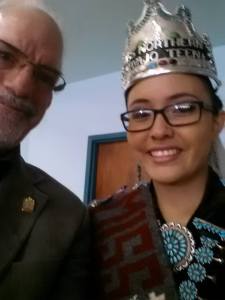Shiprock rises up from the high desert floor like a tall ship at anchor. Nearby, the Navajo town of Shiprock spreads out along the San Juan River valley, a rare stretch of fertile and well-watered land in the very northwest corner of New Mexico. I was invited to Shiprock to provide an opening prayer—in Hebrew—for the Navajo Farmers’ Appreciation Day on November 29. In his letter of invitation, Pastor Robert Tso explained, “The Navajo and Israel Agriculture Project has been the catalyst for reviving farming and agriculture on the Navajo Nation and more importantly, to cultivate our unity in support of Israel. This event is the fruit of the project.”
I was invited to Shiprock to provide an opening prayer—in Hebrew—for the Navajo Farmers’ Appreciation Day on November 29. In his letter of invitation, Pastor Robert Tso explained, “The Navajo and Israel Agriculture Project has been the catalyst for reviving farming and agriculture on the Navajo Nation and more importantly, to cultivate our unity in support of Israel. This event is the fruit of the project.”
Pastor Robert has been part of an effort to bring together Israeli farmers, with their expertise in dry land agriculture, and Navajo farmers. He also helped bring a delegation of Navajo leaders, including President Ben Shelly, to Israel, both to learn and to show the support for Israel mentioned in the letter.
So that’s why we needed an opening prayer in Hebrew, which, Pastor Robert assured me, had been requested not only by the Christian Navajo farmers, but also by secular and traditionalist farmers as well. After Pastor Robert opened with a prayer in the name of Jesus (and Yeshua), he invited me up. I started with Baruch atah Adonai Elohenu melech ha-olam, and continued in English with the prayer for a fruitful year from the Amidah—“Satisfy us from your bounty and bless our year like the best years. Blessed are you, Lord, who blesses the years.” Then the Aaronic benediction in Hebrew and English, over a quiet and alert crowd of about 250 Navajos, ranging from very young to very old. After that, four boys came up and chanted a traditional prayer in the Dine language. (“Dine” [diNEH] is the name of the nation in their own language; “Navajo” is derived from Spanish.) The opening ended with Alexandria, Miss Teenage Northern Navajo (below in my selfie), leading the Pledge of Allegiance and the Star-Spangled Banner, also in Dine.
I was moved by hearing the Navajo leaders honor their farmers, and exhort younger people to keep up the tradition. One leader, building on a core Navajo phrase, said, “To walk in beauty is to walk on the land.” I could feel the Navajo attachment to the land, the language, and the old ways, amid all the pressures to detach—and found myself rooting for the tradition. The Israel connection isn’t just agricultural, as important as that is, but a bond between two peoples who have found ways to survive in the midst of pressures toward assimilation on one hand, and obliteration on the other. Back in 2011, the Navajo Nation had issued a statement of support for Israel—one of America’s First Nations standing with what some prominent Navajos considered THE First Nation.
Navajo Farmers’ Appreciation Day was an afternoon of rural hospitality that included the Navajo Country and Western band Stone Country, a big Thanksgiving-style lunch supplemented with local specialties like fry bread and blue corn pudding, and a profound sense of blessing that flows both ways, from the Land of Israel to the vast terrain of the Navajo Nation and back again.



Thanks, Russ. It is a cool story. I had not thought about the connection of Native American and Jewish situations, both genocide and the need to not be assimilated. In the best of worlds–maybe in the Kingdom of God–these particular identities can be preserved even within a global oneness of peaceful humans.